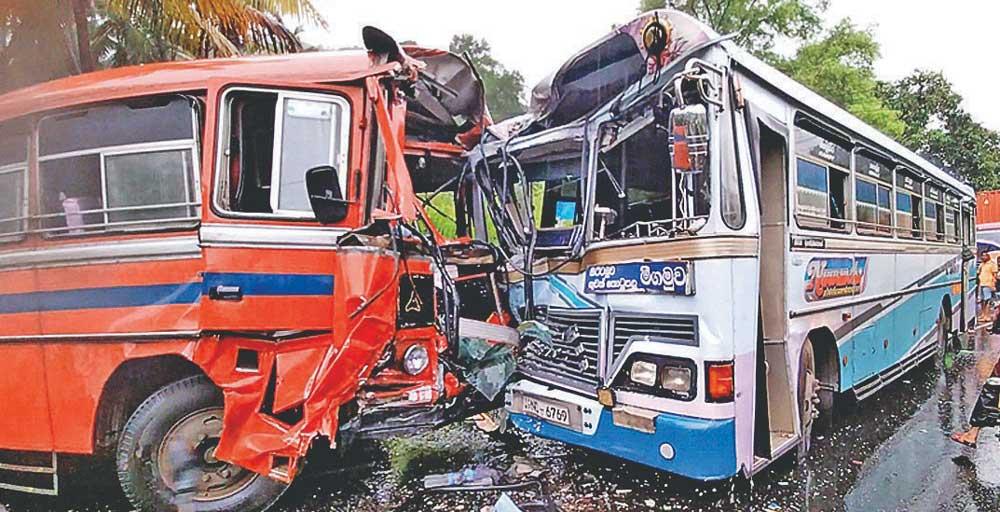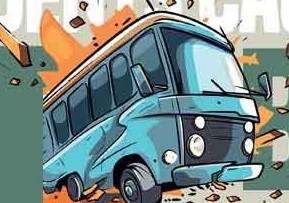Statistics have shown that, in the past, approximately eight people died each day due to road accidents. Alarmingly, this number has increased to the point where two people now die every 90 minutes.
As a solution to this issue, a project called “Sahasara” was planned with the aim of reducing road accidents. The project was initiated by Prof. Amal Kumarage, who was then an advisor to the Ministry of Highways.
By Prageeth Sampath Karunathilaka and Sudharika Gurusinghe
The accident that occurred on May 11, when an SLTB bus plunged into a precipice in the Geradi Ella area of Ramboda, has so far claimed 22 lives. The Nuwara Eliya Senior Superintendent of Police confirmed to the media that 52 people injured in the accident are currently receiving treatment at hospitals in Kandy, Gampola, Nawalapitiya, Peradeniya, and other locations.
At the time of the accident, more than 75 passengers were aboard the bus. The incident took place near a bend between the 42nd and 43rd kilometer posts on the Chenkaladi–Peradeniya road, in the Ramboda Ella area. Kataragama Depot Superintendent S. A. D. Thusitha Chaminda told the media that the driver of this SLTB bus had nearly 15 years of experience.
“The bus travels from Kataragama to Kurunegala, passing through Wellawaya, Beragala, Haputale, Bandarawela, Welimada, Nuwara Eliya, Gampola, and Kandy before reaching Kurunegala. The total journey covers around 250 kilometers and takes approximately 9 hours and 30 minutes. This driver has been operating on the Kataragama–Kurunegala route for the past four years,” he said.
Cause of accident uncertain
“We cannot yet determine the cause of the accident. We are awaiting a report from the motor vehicle inspector, who will examine the bus,” Chaminda added.
Commenting on the incident, Deputy Minister of Transport and Highways Dr. Prasanna Gunasena stated that the bus was not speeding at the time of the accident.
“As far as we know, the bus was not speeding. It appears to have been travelling at a normal speed, estimated between 20 and 30 kilometers per hour,” he said.
“However, it has been reported that a loud noise was heard from the front of the bus. Following that noise, the bus reportedly tilted toward the slope. It is believed that the bus overturned after passengers panicked,” the Deputy Minister explained.
“We must explore ways to prevent such accidents in the future. To take appropriate measures, officers have already been dispatched to the site to begin the investigation,” he added.
Currently, Nuwara Eliya Chief Motor Vehicle Inspector Jaliya Bandara has conducted a preliminary on-site examination at the scene of the accident. No signs were found indicating that the brakes were applied before the accident, and it has not been confirmed that the accident was caused by a broken suspension leaf string or any other mechanical fault. A committee has been appointed to carry out further investigations.
The bus travels nearly 255 kilometers from Kataragama to Kurunegala. The entire journey, driven by the same driver, takes around 9 to 9.5 hours. When the bus reaches Kurunegala, it is usually between 6:00 and 6:30 in the morning. The return journey from Kurunegala to Kataragama begins at 7:30 in the evening. During this time, the driver gets a break, but the conditions for rest are far from adequate.
Driver comforts neglected
There is no proper facility for him to rest, and in most cases, he is forced to sleep on an old seat removed from a bus.
In addition to this service, three other buses operate from Kurunegala to Kataragama. One departs from the Kurunegala North Depot, and another from the Kegalle Depot. The bus that leaves from Kurunegala travels to Kataragama via Wellawaya and Buttala and then returns. Another bus takes the route via Maduru Oya.This raises the question why the bus involved in the accident was assigned such a challenging route when other options were available?
The bus involved in the accident was overcrowded due to the Vesak festival in Nuwara Eliya. Under normal circumstances, the bus is used by people visiting patients at the Kandy General Hospital early in the morning, by those transporting goods for their businesses, and by employees returning to work after long holidays.The bus typically stops at two locations for tea, and it is the responsibility of the authorities to investigate whether drugs are given to drivers at these stops.
Buses built on lorry chasis
Authorities have been aware of the dangers occurring in the country’s bus service for a long time; it is not something new that arose only recently. Many so-called buses are actually built on lorry chassis. The legal limit for the number of passengers is only followed in theory—on paper. As long as officials believe that imposing fines on reckless drivers is enough to prevent accidents, road deaths will continue to rise.
When issuing permits for long-distance services, alternative side roads must be considered. A single driver is not sufficient for such journeys; there should be at least two. If private bus operators can meet this standard, the same policy should apply to SLTB buses. If not, the authorities need to pay attention to halting these challenging journeys. At the time of the accident, the bus was reportedly not speeding and had already crossed the difficult mountain terrain, travelling on flat ground. Motor vehicle inspector’s observations indicate that the brakes were not applied, and there was no visible mechanical failure, such as broken springs. It is still unclear whether the driver fell asleep due to exhaustion or whether another cause led to the tragedy. Regardless, 22 lives have been lost, and around 35 people are still receiving medical treatment.
Whenever a major accident occurs, the authorities propose various measures to prevent road accidents. Laws and regulations are updated, but accidents continue to happen.For instance, on November 1, 2024, two female students from the Kotelawala Defense University lost their lives when a bus overturned in the Dunhinda area of Badulla. The bus was carrying a group of students on a field trip. At the time of the accident, 41 people, including students from the Suriyawewa branch of the university, were on board. The accident occurred in the Ambagaha Oya area, close to the Dunhinda access road on the Badulla–Mahiyanganaya main road. According to a statement from the Police Media Spokesperson’s Office, the driver lost control of the bus, causing it to overturn near a bend.
Another tragic incident occurred on the night of January 20, 2023, when a bus carrying students from Thurstan College, Colombo, was involved in an accident in the Radella area, Nanu Oya, during an educational trip.
The driver lost control, and the bus collided with a van and a three-wheeler before plunging into a precipice. While all the students on board were rescued safely, the two drivers of the van and three-wheeler, along with five members of the same family, were killed.The bus driver later claimed that the brakes had failed. However, eyewitnesses stated that the accident was caused by the driver’s reckless driving.
This accident sparked widespread social discussion. Many people took to social media to share their experiences and opinions about the reckless driving habits of bus drivers.
Despite that, the responses from the relevant authorities remain unclear, and it is still uncertain what concrete steps have been taken so far. While certain policies were introduced regarding the transportation of school children on trips, there are doubts about whether these measures are being properly implemented today.
Alarming accident death rates
Statistics have shown that, in the past, approximately eight people died each day due to road accidents. Alarmingly, this number has increased to the point where two people now die every 90 minutes. In addition, around 12 people are injured daily in road accidents.
Police data also indicates that three-wheeler drivers and motorcyclists are among the most vulnerable groups. On July 10, 2023, Sri Lanka witnessed two fatal bus accidents, resulting in the deaths of 12 passengers and injuries to more than 70 others.
One accident occurred when a private bus travelling from Kaduruwela to Akkaraipattu overturned after falling off the Kotaleeya Bridge in Manampitiya. The other involved a bus returning from the Kuragala pilgrimage, which collided with the back of a lorry parked on the roadside in the Ambanpola area on the Anuradhapura–Kurunegala road. Similarly, a private bus travelling from Watagoda in Talawakele to MadakumburaWatta overturned in the Kirindiketiya area in Dunukedeniya. Although 26 people were hospitalised in that incident, there were no reported fatalities.
Since both fatal accidents involved private buses and it was revealed that they were speeding beyond the legal limit, many people have blamed the drivers for the tragedies.
30,000 buses in operation
Approximately 30,000 SLTB and private passenger buses operate on the roads of the country. Among them, the private bus sector appears to be more eager to increase the number of trips. Several surveys have revealed that the relaxation in adherence to traffic laws is a major cause of fatal accidents.
As a solution to this issue, a project called “Sahasara” was planned with the aim of reducing road accidents. The project was initiated by Prof. Amal Kumarage, who was then an advisor to the Ministry of Highways. He pointed out that repeated accidents are largely due to weaknesses in the professional standards of drivers and the lack of scientific methods in accident control.


Driver fatigue is a contributing factor as does carelessness
“When an accident occurs, there is no scientific investigation in our country. A scientific approach involves analysing all the contributing factors and drawing conclusions accordingly. This includes not only identifying who is at fault, but also considering the condition of the road, the driver’s mental state, and other relevant factors. Without such investigations, it is impossible to prevent recurring accidents.”
When introducing the Sahasara project, Prof.Kumarage noted that it would address all these aspects. The system is designed to resemble public transport models used in European countries.
Under this model, the financial transaction occurs not between the passenger and the bus owner directly, but between the passenger and a specially established institution. The bus owner is then paid from the revenue collected by this fully state-owned institution.
The primary aim is to eliminate the competition among bus owners because they are paid on the basis of the number of kilometers driven. The pilot project was first launched in the Central Province, where it successfully reduced the waiting time for passengers to access public transport by 30%.At the time, there were discussions to involve the Sri Lanka Transport Board in the process, but the project was halted following a change in government.
Many promising projects in this country have failed due to the habit of changing policies whenever ministers, governments, or presidents change. Therefore, what is truly needed is a national programme to minimise road accidents. Without such a programme, it should not be left to government officials who rush to announce measures when an accident occurs, only to forget about them later and turn the issue into a political statement.
